National Security and Investment Act 2021: Annual Report 2024-25 (HTML)
Published 22 July 2025
Foreword by the Chancellor of the Duchy of Lancaster
We are living through a period of immense change. Geopolitical instability, and a fracturing of the old liberal order. Conflict in the Middle East, and Russia continuing to wage war on the sovereign nation of Ukraine. Layered on top of global instability is a rapid acceleration in frontier technologies, like Artificial Intelligence, which have the potential to profoundly reshape everything from the future of work to our national security.
Against this backdrop, the number one mission of this Government - delivering economic growth and improving living standards - becomes even more urgent. To thrive in this environment, our policies and programmes need to send an unambiguous message to businesses across the globe: the UK is open for business.
That is exactly what the National Security Investment Act does. It makes sure the UK’s takeovers regime is one that facilitates investment in sensitive parts of our economy, while safeguarding our national interests. A framework that encourages innovation and stimulates growth while protecting our competitive advantages. Most importantly, it recognises that, in 2025, economic security is national security.
As the pages of this annual report make clear, the NSI Act is playing a fundamental role in the overall health of our economy.
And it is now complemented by a dedicated Industrial Strategy and National Security Strategy. Together these blueprints set out how we will not only tackle the geopolitical and industrial challenges of this new era, but make sure Britain seizes the opportunity to grow new strengths and develop new competitive advantages.
Over the course of the last financial year we received 1,143 notifications in total - over 25% more than the previous year. Reviews were completed for 1,079 notifications, 95.5% of which were notified that no further action would be taken, and only 4.5% were called in. In total 56 acquisitions were called in for further assessment, 16 were issued with final orders allowing them to proceed under certain conditions, and just one was ordered to unwind.
These statistics are testament to a system that is working. The vast majority of inward investment continues to pose no threat to our national security, and most businesses will never need to interact with the takeover screening process.
As with all legislation, it is imperative our rules keep pace with the scale and speed of innovation we are witnessing, along with our own wider economic priorities. We are three years into the NSI Act, and the Government is armed with a much deeper understanding of what makes an effective takeover regime. We plan to apply that knowledge as we consider whether improvements to the system can be made in the coming years.
But as this Annual Report makes clear, our focus will always be on fostering a business environment conducive to growth. One where inward investment is welcomed and our businesses feel protected. The National Security Investment Act helps make that possible.
Executive Summary
1. This report is a statutory requirement, laid before Parliament under Section 61 of the National Security and Investment Act 2021 (“the NSI Act”). It covers the year from 1 April 2024 to 31 March 2025 (“the reporting period”), containing all the information that is required by the NSI Act and additional information to aid understanding and transparency.
2. The Government is committed to ensuring the NSI Act protects our national security, and does so as effectively, efficiently, and transparently as possible - giving investors the certainty they need to kickstart growth across the UK.
Overview of this report’s content
3. In this report, the term ‘the Government’ refers to the decision-maker. The Investment Security Unit (ISU) administers the operation of the NSI Act.
4. This is the fourth annual report on the operation of the NSI Act and the third to cover an entire financial year. The report includes year-on-year comparisons with the previous reporting period and an accompanying spreadsheet containing all data published since the commencement of the NSI Act. Comparisons are made throughout the report using data included in this report and data published in the previous reporting period. Some figures from the previous reporting period have been revised for improved accuracy. The revised figures can be found in the accompanying spreadsheet.
5. The NSI Act requires each annual report to contain specific details on the operation of the NSI Act. This report contains information and comparisons that go beyond the statutory minimum.
6. Annex D contains a diagram which illustrates the progress of acquisitions reviewed throughout the reporting period. This includes transactions where the review began in the previous reporting period, and transactions where the review will continue into the next reporting period.
Notifications Received
7. In the reporting period the ISU received 1,143 notifications[footnote 1], an increase from 906 notifications received in the previous reporting period. Of the 1,143 notifications received, 954 were mandatory notifications, 134 were voluntary notifications, and 55 were retrospective validation applications[footnote 2].
8. The Government accepted 1,110 notifications (an increase from 876 in the previous reporting period) and rejected 37 notifications during the reporting period, (an increase from 24 notifications in the previous reporting period). The 1,110 accepted notifications comprised 942 mandatory notifications, 116 voluntary notifications, and 52 retrospective validation applications.
Call-in notices, withdrawals, final notifications, and final orders
9. During the reporting period, the Government reviewed 1,079 notified acquisitions, an increase from 847 notified acquisitions reviewed in the previous reporting period. Of the 1,079 notifications reviewed, 4.5% (49) were issued with a call-in notice[footnote 3] and 95.5% (1,030) were notified that no further action would be taken. This is broadly consistent with the previous reporting period, during which 4.4% of notified acquisitions were issued with a call-in notice and 95.6% were notified that no further action would be taken.
10. In addition to the 49 notified acquisitions called in during the reporting period, seven non-notified acquisitions[footnote 4] were issued with a call-in notice. Therefore, the Government issued a total of 56 call-in notices in the reporting period, an increase from 41 in the previous reporting period.
11. Of the 56 call-in notices issued during the reporting period, 28 related to a mandatory notification, 20 related to a voluntary notification, one related to a retrospective notification, and seven were in relation to non-notified acquisitions.
12. The Government issued 35 final notifications[footnote 5] (which includes four withdrawn notifications) and issued 17 final orders[footnote 6],[footnote 7], varied[footnote 8] three final orders and revoked[footnote 9] three final orders during the reporting period. For comparison, the Government issued 33 final notifications and five final orders, varied three final orders and revoked no final orders during the previous reporting period.
13. Of the 35 final notifications, 20 were following a mandatory notification, 11 were following a voluntary notification, and four were related to non-notified acquisitions. No final notifications were issued in connection with a retrospective validation application.
14. There were five instances where parties withdrew from a called-in acquisition, a decrease from 10 in the previous reporting period. Of the five withdrawals, four were following a mandatory notification, and one involved a non-notified acquisition.
15. Of the 17 final orders issued, 11 were following a mandatory notification, five following a voluntary notification, and one involved a non-notified acquisition.
Notifications and acquisitions, by area of the economy
Note 1: Acquisitions can be associated with more than one area of the economy. Therefore the number of notifications, call-in notices, final notifications, withdrawals, and final orders issued, broken down by area of the economy may add up to more than the total number of notifications, call-in notices, final notifications, withdrawals, and final orders.
16. In the reporting period, the largest proportion of notifications either accepted or rejected was associated with the Defence area of the economy (56%), followed by Critical Suppliers to Government (21%) and Military and Dual-Use (19%). For comparison, the largest proportion of notifications either accepted or rejected in the previous reporting period was associated with the Defence area of the economy (48%).
17. Of the 56 acquisitions called in, the largest proportion was associated with the Defence area of the economy (36%), followed by Military and Dual-Use (29%) and Advanced Materials (27%). For comparison, the largest proportion of acquisitions called in during the previous reporting period was associated with the Defence area of the economy (34%).
18. Of the 35 final notifications issued during the reporting period, the largest proportion was associated with acquisitions in the Defence area of the economy (37%), followed by Military and Dual-Use (34%) and Advanced Materials (29%) and Artificial Intelligence (29%). For comparison, the largest proportion of final notifications issued in the previous reporting period was associated with acquisitions in the Defence area of the economy (30%).
19. Of the five occasions on which parties withdrew from a called-in acquisition, the largest number was associated with acquisitions in the Defence area of the economy (four withdrawals), followed by Critical Suppliers to Government (three withdrawals), Advanced Materials (two withdrawals) and Military and Dual-Use (two withdrawals).
20. Of the 17 final orders issued during the reporting period, the largest number was associated with acquisitions in the Defence area of the economy (nine final orders), followed by Military and Dual-Use (six final orders), and Energy (five final orders). For comparison, the largest number of final orders issued in the previous reporting period was associated with acquisitions in the Defence area of the economy (four final orders).
Notifications and acquisitions, by origin of investment
Note 2: Acquisitions can be associated with more than one origin of investment as an acquisition can involve multiple acquirers, and acquirers can be associated with multiple origin of investments. Therefore the number of notifications, call-in notices, final notifications, withdrawals, and final orders issued, broken down by origin of investment, may add up to more than the total number of notifications, call-in notices, final notifications, withdrawals, and final orders.
21. In the reporting period, the largest proportion of accepted notifications involved acquirers associated with the United Kingdom (65%), followed by acquirers associated with the United States of America (29%), acquirers associated with France (6%) and acquirers associated with Luxembourg (6%). For comparison, the largest proportion of accepted notifications in the previous reporting period involved acquirers associated with the United Kingdom (61%).
22. Of the 56 acquisitions called in, the largest proportion involved acquirers associated with the United Kingdom (48%), followed by acquirers associated with China (32%) and acquirers associated with the United States of America (20%). For comparison, the largest proportion of called-in acquisitions in the previous reporting period involved acquirers associated with China (41%).
23. Of the 35 final notifications issued, the largest proportion involved acquirers associated with the United Kingdom (34%), followed by acquirers associated with China (23%) and acquirers associated with the United States of America (20%). For comparison, the largest proportion of final notifications issued in the previous reporting period involved acquirers associated with China (48%).
24. Of the five acquisitions withdrawn after call-in, the largest number involved acquirers associated with the United Kingdom (three withdrawals), followed by Austria, France, Greece, Jersey, Netherlands, Panama, Russia and the United States of America. (one withdrawal each).
25. Of the 17 final orders issued, the largest number involved acquirers associated with the United Kingdom (11 final orders), followed by acquirers associated with China (seven final orders) and acquirers associated with the United States of America (three final orders). For comparison, the largest number of final orders in the previous reporting period involved acquirers associated with the United Kingdom (two final orders) and the United States of America (two final orders).
Notifications and acquisitions, by the time taken
Note 3: The counting of statutory working days in the assessment period[footnote 10] is paused if transaction parties are asked to respond to an information notice[footnote 11] or an attendance notice[footnote 12]. The use of an information notice does not affect the number of working days during the review period[footnote 13]. All counts of case timings exclude days which are bank holidays in any part of the United Kingdom.
All average timings presented in the executive summary use median values, as this is less affected by outliers (large or small numbers) than the mean values.
26. In the reporting period, it took on average 7 working days from receipt of a mandatory notification to acceptance, 8 days for voluntary notifications, and 6 days for retrospective validations. In comparison, the previous reporting period saw an average of 6 working days from receipt of a mandatory notification to acceptance, 8 days for voluntary notifications, and 7 days for retrospective validations.
27. In the reporting period, it took on average 20 working days from receipt of a mandatory notification to giving written reasons for a decision to reject that notification, 16 days for voluntary notifications. In comparison, the previous reporting period saw an average of 13 working days from receipt of a mandatory notification to rejection, and 15 days for voluntary notifications. No retrospective validation application was rejected in this reporting period.
28. The Government took all decisions on whether to call-in or clear notified acquisitions within the review period’s statutory 30 working days. For notifications that were called in, it took on average 29 statutory working days to issue a call-in notice once a mandatory notification was accepted and 29 once a voluntary notification was accepted. For comparison, it took on average 29 statutory working days to issue a call-in notice after accepting a mandatory or a voluntary notification in the previous reporting period.
29. The additional period was used 21 times, an increase from 12 times in the previous reporting period. Of the 21 times the additional period was used, 14 were related to mandatory notifications, four were related to voluntary notifications, and three were related to non-notified acquisitions.
30. Use of the voluntary period was agreed twice, a decrease from three times[footnote 14] in the previous reporting period. Of the two times the voluntary period was agreed, one was related to mandatory notifications and one to non-notified acquisitions.
31. Of the 35 final notifications issued, five used the additional period and the voluntary period was not required for any. Of the 17 final orders issued this reporting period, all 17 used the additional period and the voluntary period was agreed for one.
32. On average, it took 24 statutory working days or 40 calendar days to issue a final notification from the point an acquisition was called in during the assessment period. In the previous reporting period, the average number of statutory working days between calling in an acquisition and issuing a final notification was 26 statutory days or 48 calendar days.
33. On average, it took 70 statutory working days or 100 calendar days to issue a final order from the point an acquisition was called in. For comparison, it took an average of 34 statutory working days or 53 calendar days to issue a final order from the point an acquisition was called in during the previous reporting period. Due to the small number of final orders (five) in the previous reporting period, no conclusions should be drawn regarding trends in the time taken between calling in an acquisition and issuing a final order.
Enforcement and assistance
34. No financial assistance was given during the reporting period. No penalties were issued, nor any criminal prosecutions concluded. Where offences were identified but the decision was made not to impose a penalty, parties were required to provide reassurance to the Government that steps had been taken to prevent any recurrence. During the reporting period, the Government identified 60 offences of completing a notifiable acquisition without approval for which parties were required to provide reassurance that steps had been taken to prevent any recurrence.
Further information
The Government has published extensive guidance on gov.uk which provides further details on the operation of the NSI Act, including the process for submitting notifications.
SECTION ONE: Notifications
1. This section contains information about the notifications that the Government received during the reporting period. Notifications by area of the economy can be found on page 20, and notifications by origin of investment are on page 24.
2. Notifications are the means by which parties give notice to the Government about acquisitions that meet the legal tests set out in the NSI Act. The vast majority of activity in the UK economy in any given year will not need to be notified to the Government.
3. Parties to acquisitions can make three types of notification under the NSI Act:
a. Mandatory notifications are those received in relation to ‘notifiable acquisitions’, which are certain acquisitions of entities carrying out certain activities in the 17 sensitive areas of the UK economy specified in the Notifiable Acquisition (Specification of Qualifying Entities) Regulations 2021.
b. Voluntary notifications are those received in relation to acquisitions of entities which are not covered by mandatory notification requirements, and of assets. Parties may submit notifications voluntarily to achieve business certainty.
c. Retrospective validation applications are applications for notifiable acquisitions to be recognised retrospectively as being valid in law after they have been completed without approval.
4. In this report, “notifications” refers collectively to mandatory notifications, voluntary notifications, and retrospective validation applications.
Notifications received
5. Once a notification is received, the Government must either accept the notification (meaning it can be reviewed) or reject the notification. Reasons for rejecting a notification are outlined in Figure 5 on page 12.
Table 1
| ID | Information | Number |
|---|---|---|
| A | The total number of notifications received | 1,143 |
| B | The number of mandatory notifications received | 954 |
| C | The number of voluntary notifications received | 134 |
| D | The number of retrospective validation applications received | 55 |
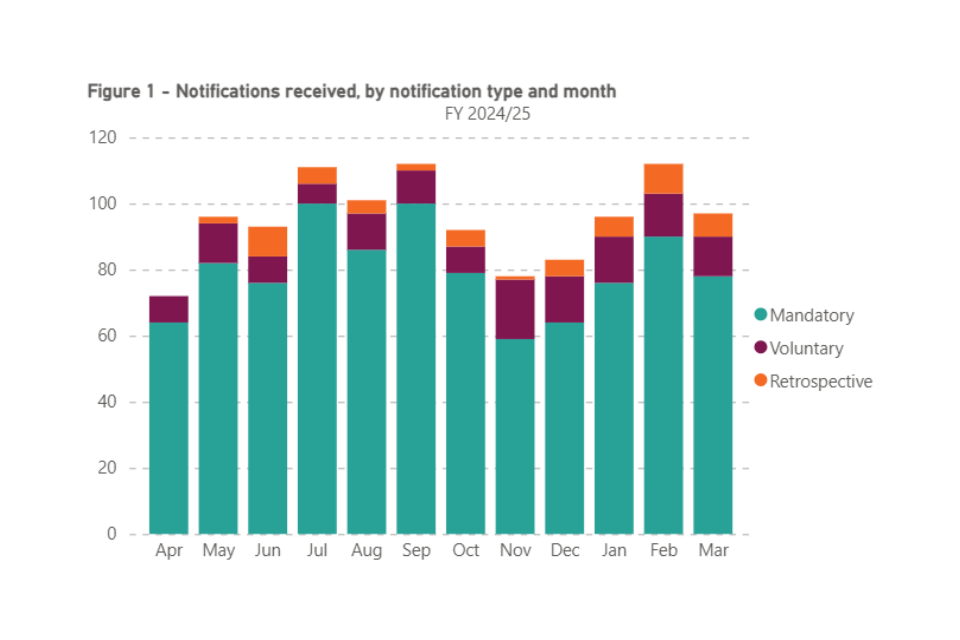
6. Figure 1 presents the total number of notifications received, broken down by notification type in each month of the reporting period, which totalled 1,143 over the reporting period. This is an increase from 906 notifications received in the previous reporting period. The most notifications (112) were received in September 2024 and February 2025, and the fewest (72) were received in April 2024. More than seven times as many mandatory notifications were received as voluntary notifications.
Notifications accepted or rejected
7. This section includes notifications accepted or rejected in the reporting period. Notifications received towards the end of a reporting period may be accepted or rejected after the reporting period closes. Additionally, notifications accepted or rejected in a reporting period might have been received in a previous reporting period. As a result, there may be discrepancies between the total number of notifications received and the total number of notifications accepted and rejected within the reporting period.
Table 2
| ID | Information | Number |
|---|---|---|
| E | The total number of notifications accepted or rejected | 1,147 |
| F | The total number of notifications accepted | 1,110 |
| G | The total number of notifications rejected | 37 |
| H | The number of mandatory notifications accepted | 942 |
| I | The number of mandatory notifications rejected | 18 |
| J | The number of voluntary notifications accepted | 116 |
| K | The number of voluntary notifications rejected | 19 |
| L | The number of retrospective validation applications accepted | 52 |
| M | The number of retrospective validation applications rejected | 0 |
| N | The number of notifications pending acceptance or rejection at the end of the reporting period | 33 |
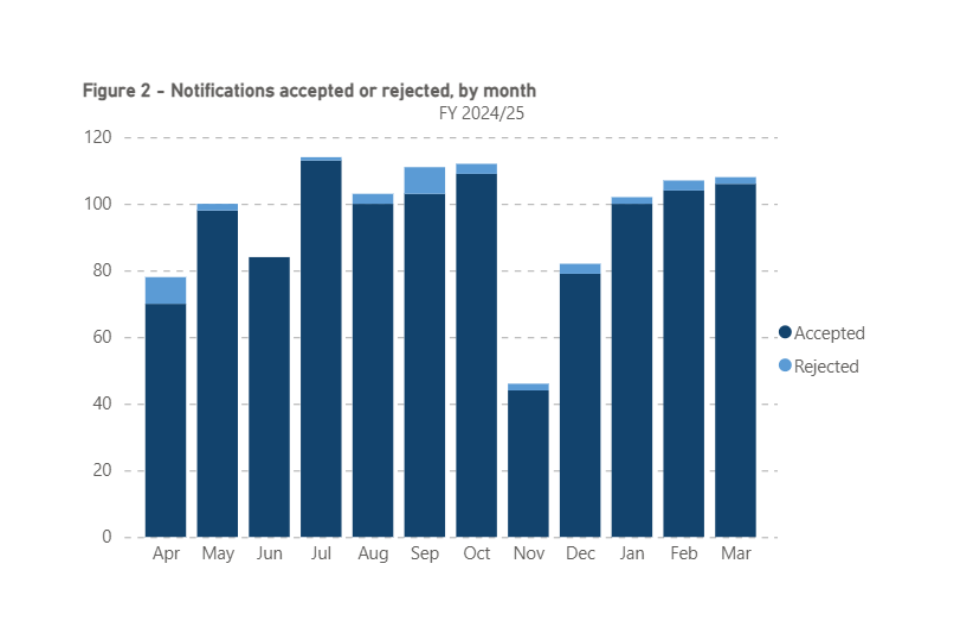
8. Figure 2 presents the number of notifications that were accepted or rejected during each month of the reporting period. The large majority of notifications received were accepted (97%), with only a small minority being rejected (3%). Figure 5 provides a detailed breakdown of the reasons why the Government has rejected notifications.
9. The total number of accepted notifications has increased from 876 in the previous reporting period to 1,110. The total number of notifications rejected has also increased from 24 to 37.
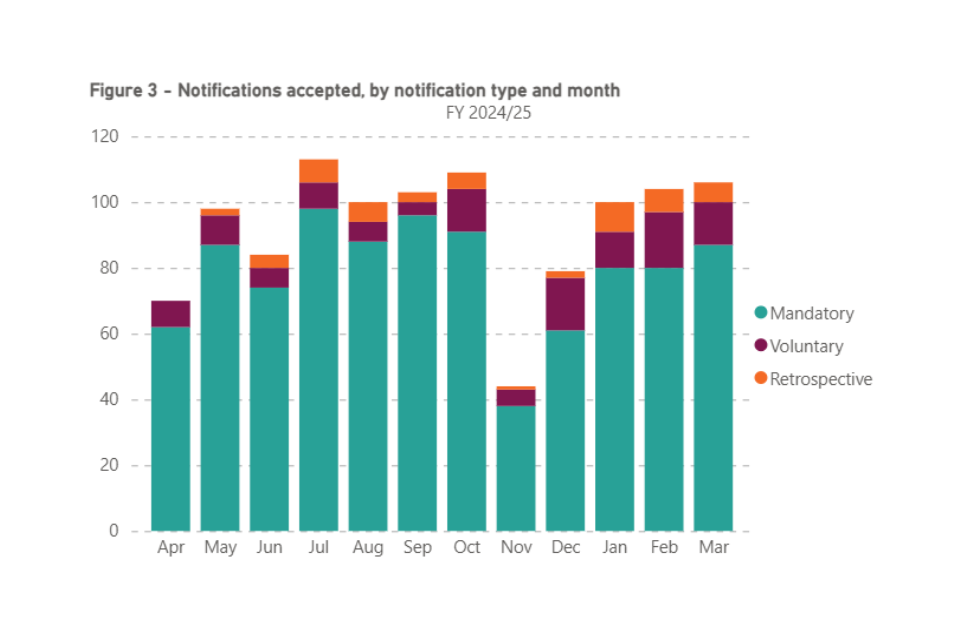
10. Figure 3 presents the number of notifications accepted broken down by notification type in each month of the reporting period. The chart illustrates that November 2024 had the lowest number of notifications accepted (44), while July 2024 had the largest number of accepted notifications (113).
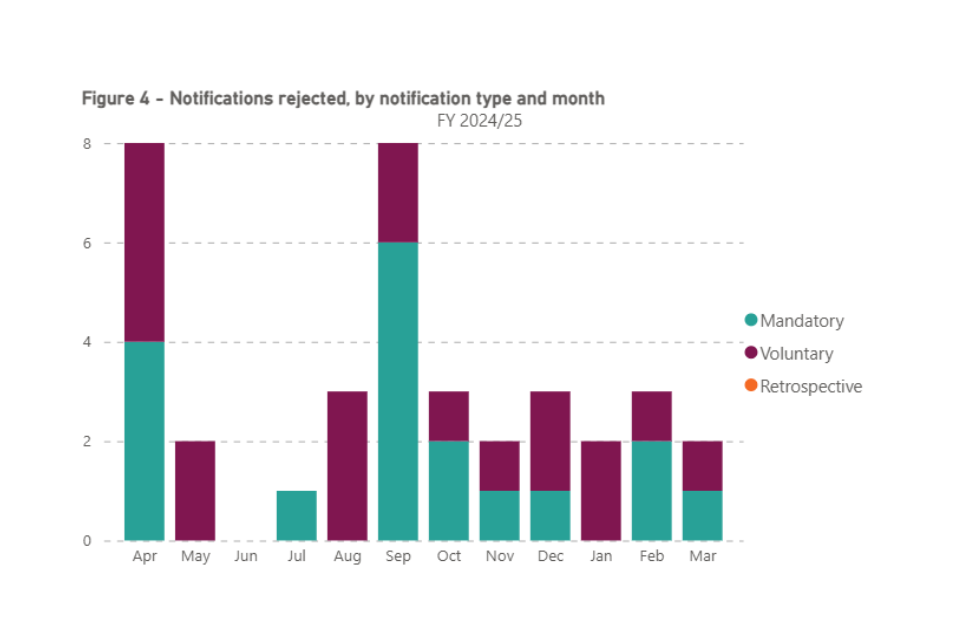
11. Figure 4 presents the number of rejected notifications broken down by notification type in each month of the reporting period. The largest proportion of rejected notifications was voluntary notifications with 19 (51%), followed by mandatory notifications with 18 (49%). There were no retrospective validation notifications rejected in the reporting period.
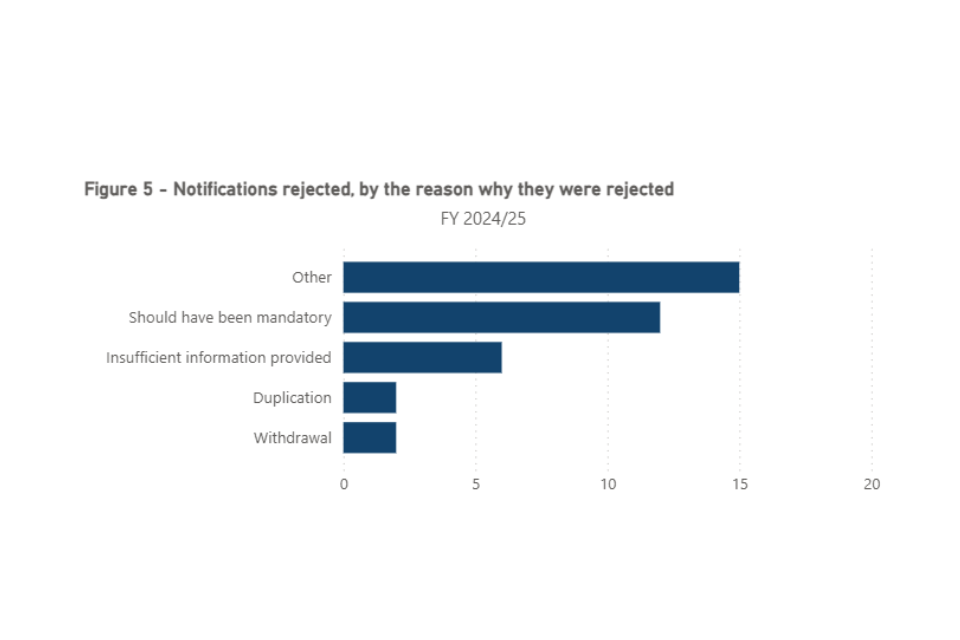
12. Figure 5 presents a breakdown of the reasons why the Government has rejected a notification. The most common reason for rejecting a notification was that the acquisition should have been notified as a mandatory notification (12 notifications rejected out of 37 in total). When the Government rejects a notification, officials contact parties to explain why the notification was rejected.
SECTION TWO: Call-in notices
1. This section contains information about notified and non-notified acquisitions that have been reviewed during the reporting period. This is different to the number of notifications that have been received and accepted or rejected because not all acquisitions called in were notified, and because the Government may have received or accepted a notification in a previous reporting period but reviewed the notification in the reporting period.
2. The Government can only call in an acquisition for further scrutiny if it reasonably suspects a qualifying acquisition may give rise to a risk to national security. Call-in notices may be issued concerning any qualifying acquisition, whether or not it has been notified.
3. The number of call-in notices issued by area of the economy can be found on page 21, and the number of call-in notices issued by origin of investment can be found on page 25.
Notifications reviewed & call-in notices issued
Table 3
| ID | Information | Number |
|---|---|---|
| A | The total number of notified acquisitions reviewed | 1,079 |
| B | The number of acquisitions reviewed following a mandatory notification | 912 |
| C | The number of acquisitions reviewed following a voluntary notification | 120 |
| D | The number of acquisitions reviewed following a retrospective validation application | 47 |
| E | The total number of call-in notices issued | 56 |
| F | The number of call-in notices issued following a mandatory notification | 28 |
| G | The number of call-in notices issued following a voluntary notification | 20 |
| H | The number of call-in notices issued following a retrospective validation application | 1 |
| I | The number of call-in notices issued for non-notified acquisitions | 7 |
4. Table 3 shows that the total number of notified acquisitions reviewed was 1,079. This is an increase from 847 acquisitions reviewed in the previous reporting period.
5. Of the 1,079 notifications reviewed, 95.5% (1,030) were cleared to proceed within the review period. This is broadly consistent with the previous reporting period (95.6%).
6. Of the 1,079 notified acquisitions reviewed, 4.5% (49[footnote 15]) were issued a call-in notice. This is broadly consistent with the 4.4% (37) notified acquisitions issued with a call-in notice during the previous reporting period.
7. Seven non-notified acquisitions reviewed by the Government in the reporting period were issued with a call-in notice, giving a total of 56 call-in notices. This is an increase from the 41 call-in notices issued during the previous reporting period.
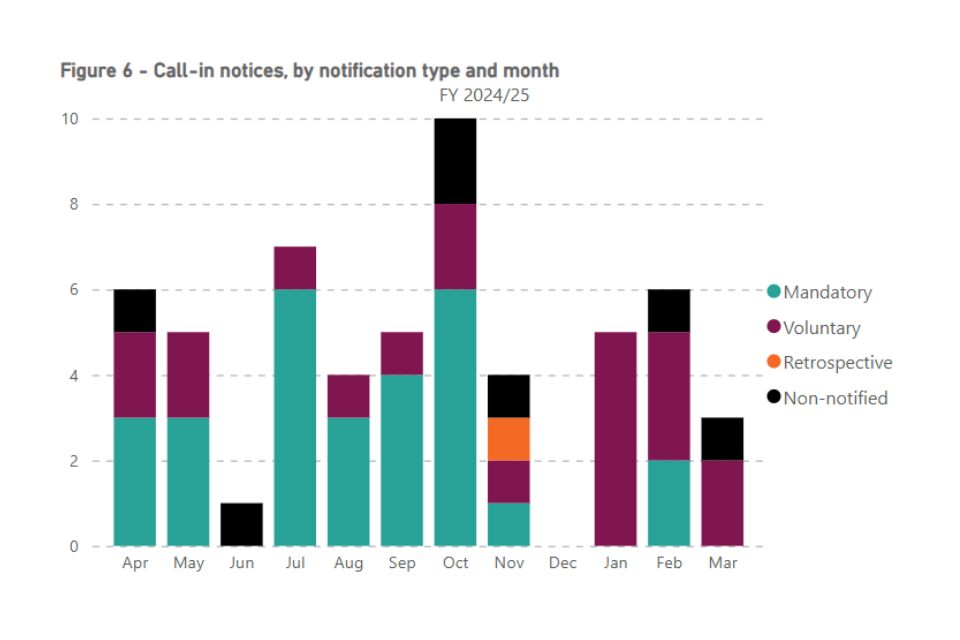
8. Figure 6 presents the number of call-in notices broken down by notification type in each month of the reporting period. The chart illustrates that the largest proportion of call-in notices issued was following a mandatory notification (50%). This is followed by voluntary notifications (36%), non-notified acquisitions (13%), and retrospective validations (2%).
SECTION THREE: Final notifications
1. This section contains information about the final notifications the Government issued during the reporting period. The number of final notifications issued by area of the economy can be found on page 22, and the number of final notifications issued by origin of investment can be found on page 26.
2. Following a call-in and subsequent assessment period, the Government may clear an acquisition with no further action by issuing a final notification. In these circumstances, the Government cannot take any further action unless it was given materially false or misleading information.
3. The number of call-in notices issued in the reporting period is different to the total number of final notifications and final orders notices issued in the reporting period. This is because some of the acquisitions called in during this period will not receive a final decision until the next reporting period and because some final orders and final notifications issued in the reporting period relate to acquisitions called in during the previous reporting period.
Final notifications issued
Table 4
| ID | Information | Number |
|---|---|---|
| A | The total number of final notifications issued | 35 |
| B | The number of final notifications issued following a mandatory notification | 20 |
| C | The number of final notifications issued following a voluntary notification | 11 |
| D | The number of final notifications issued following a retrospective validation application | 0 |
| E | The number of final notifications issued for non-notified acquisitions | 4 |
4. In the reporting period, the Government assessed 52 called-in acquisitions to make a decision whether to give a final notification (35) or make a final order (17). This is an increase from 38 in the previous reporting period. Of the 52 called-in acquisitions on which the Government made a decision, 67% (35) were cleared, resulting in a final notification.
Withdrawals from a called-in acquisition
5. Parties may withdraw from acquisitions at any time. Where parties withdraw from an acquisition that has been called in, the Government issues a final notification to end the assessment period.
6. The total number of final notifications issued (presented above) includes the total number of withdrawals from a called-in acquisition.
Table 5
| ID | Information | Number |
|---|---|---|
| F | The total number of withdrawals from a called-in acquisition | 5 |
| G | The number of withdrawals from a called-in acquisition following a mandatory notification | 4 |
| H | The number of withdrawals from a called-in acquisition following a voluntary notification | 0 |
| I | The number of withdrawals from a called-in acquisition following a retrospective validation application | 0 |
| J | The number of withdrawals from a called-in acquisition for non-notified acquisitions | 1 |
7. The total number of withdrawals post call-in has decreased to 5, compared to 10 in the previous reporting period.
SECTION FOUR: Final orders
1. This section contains information about the final orders the Government issued during the reporting period. The number of final orders issued by area of the economy can be found on page 23, and the number of final orders issued by origin of investment can be found on page 27.
2. The Government may issue a final order to mitigate risks to national security arising from an acquisition. This may include imposing certain conditions, preventing an acquisition from taking place or requiring an acquirer to unwind the acquisition.
3. Some final orders issued in the reporting period may relate to acquisitions that were called in during the previous reporting period, and some acquisitions called in during the reporting period had not reached a conclusion by the end of the reporting period.
Final orders issued
Table 6
| ID | Information | Number |
|---|---|---|
| A | The total number of final orders issued | 17 |
| B | The number of final orders issued following a mandatory notification | 11 |
| C | The number of final orders issued following a voluntary notification | 5 |
| D | The number of final orders issued following a retrospective validation application | 0 |
| E | The number of final orders issued for non-notified acquisitions | 1 |
| F | The number of acquisitions blocked or subject to an order to unwind the acquisition | 1 |
4. In the reporting period, the Government assessed 52 called-in acquisitions to make a decision whether to issue a final notification or a final order. Of these, 17[footnote 16] (33%) resulted in a final order. This is an increase from five final orders issued in the previous reporting period. One acquisition was subject to an order to unwind.
Table 7
| ID | Information | Number |
|---|---|---|
| G | The number of final orders varied | 3 |
| H | The number of final orders revoked | 3 |
5. The Government must keep each final order under review and may vary or revoke them. A person required to comply with a final order may request that the Government vary or revoke an order but the Government is not required to consider such a request if there has been no material change in circumstances since the final order was issued or last varied or the last request for variation was received. During the reporting period, three final orders were varied and three were revoked.
6. A summary of each final order, variation, and revocation is published on gov.uk
SECTION FIVE: Areas of the economy
1. This section breaks down the number of accepted or rejected notifications, call-in notices, final notifications issued, withdrawals from a called-in acquisition and final orders issued by area of the economy.
2. Acquisitions can be associated with more than one area of the economy. The percentages in the charts in this section therefore add up to more than 100%. Notifications may also appear more than once, as a notification can be rejected and then resubmitted and accepted. The charts which display information on acquisitions that were called in include notified acquisitions and non-notified acquisitions
Notifications accepted or rejected, by area of the economy
3. Notifications are associated with areas of the economy when they are accepted or rejected, based on information provided by parties in their notifications. Figure 7 therefore only includes data on the notifications that were accepted or rejected within the reporting period[footnote 17], not all notifications that were received in the reporting period.
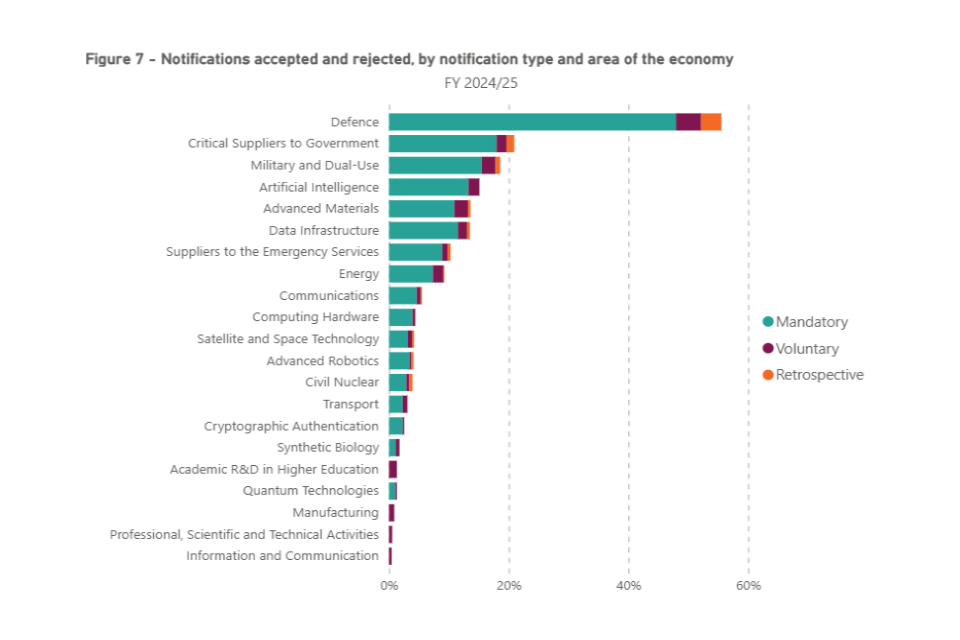
4. Figure 7 presents notifications accepted or rejected during the reporting period, broken down by area of the economy. The chart shows that the largest proportion was associated with the Defence area of the economy (56%), followed by Critical Suppliers to Government (21%) and Military and Dual-Use (19%).
5. For comparison, the largest proportion of notifications either accepted or rejected in the previous reporting period was associated with the Defence area of the economy (48%).
6. Accepted and rejected notifications were associated with 32 areas of the economy, including all 17 areas of the economy subject to a mandatory notification.
Call-in notices issued, by area of the economy
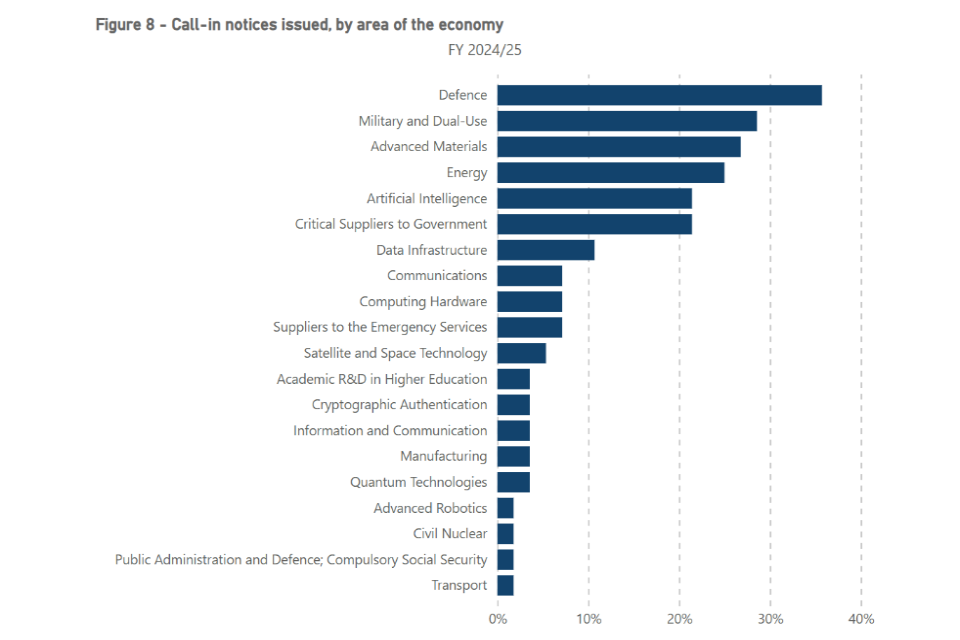
7. Figure 8 presents the 56 call-in notices issued during the reporting period, broken down by area of the economy. The chart shows that the largest proportion was associated with the Defence area of the economy (36%), followed by Military and Dual-Use (29%) and Advanced Materials (27%). It is important to note that this means that 36% of called-in acquisitions were associated with Defence, not that 36% of Defence acquisitions were called in.
8. For comparison, the largest proportion of call-in notices issued during the previous reporting period was associated with the Defence area of the economy (34%).
9. Call-in notices were issued in connection with acquisitions in 16 of the 17 areas of the economy subject to mandatory notification, as well as a small number of other areas of the economy such as Manufacturing, and Academic Research & Development in Higher Education. No call-in notices were associated with the Synthetic Biology area of the economy.
Final notifications issued, by area of the economy
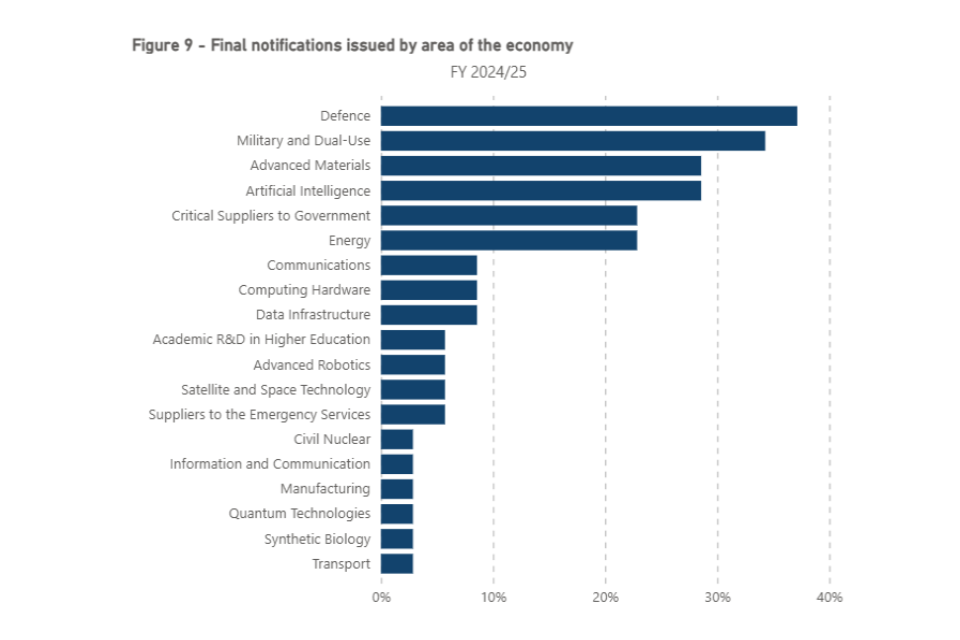
10. Figure 9 presents the 35 final notifications issued during the reporting period, broken down by area of the economy. The chart shows that the largest proportion was associated with acquisitions in the Defence area of the economy (37%), followed by Military and Dual-Use (34%) and Advanced Materials (29%) and Artificial Intelligence (29%).
11. For comparison, the largest proportion of final notifications issued in the previous reporting period was associated with acquisitions in the Defence (30%) area of the economy.
Withdrawals from a called-in acquisition, by area of the economy
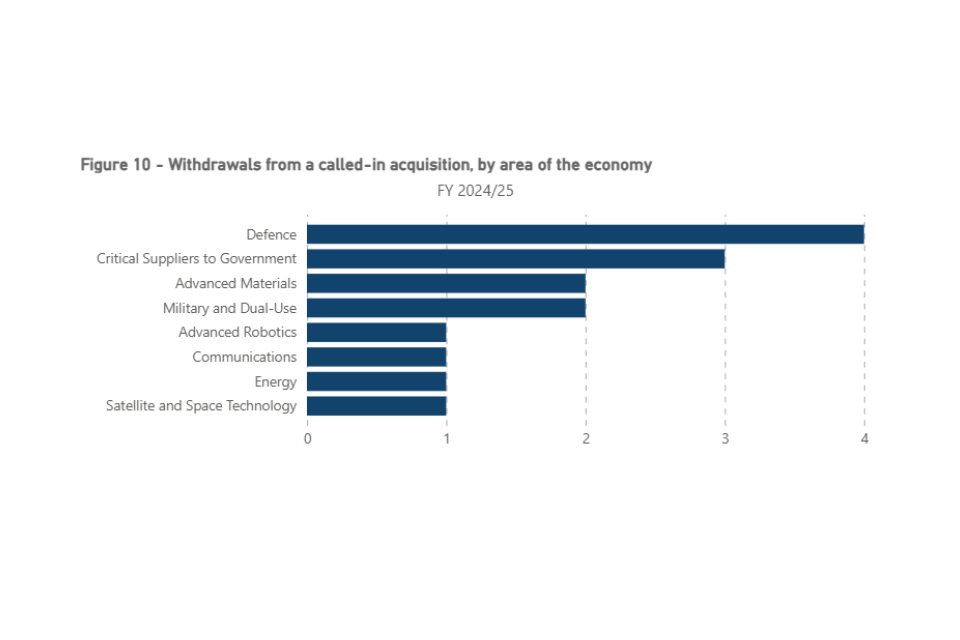
12. Figure 10 presents the five withdrawals from a called-in acquisition during the reporting period, broken down by area of the economy. The chart shows that the largest number was associated with acquisitions in the Defence area of the economy (four withdrawals), followed by Critical Suppliers to Government (three withdrawals), Advanced Materials (two withdrawals) and Military and Dual-Use (two withdrawals).
Final orders issued, by area of the economy
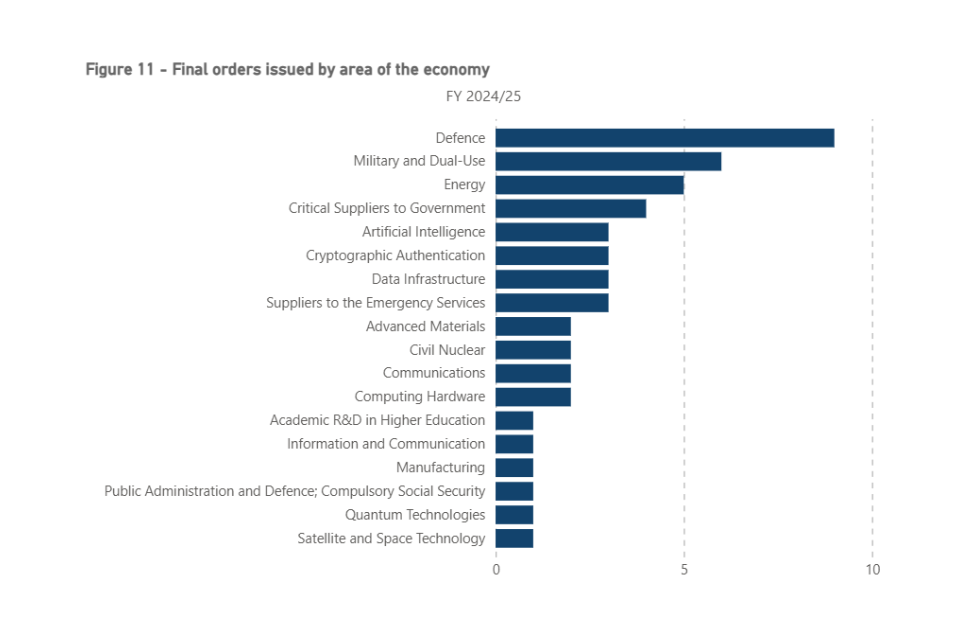
13. Figure 11 presents the 17 final orders issued during the reporting period, broken down by area of the economy. The chart shows that the largest number was associated with acquisitions in the Defence area of the economy (nine final orders), followed by Military and Dual-Use (six final orders), and Energy (five final orders).
14. For comparison, the largest number of final orders issued in the previous reporting period was associated with acquisitions in the Defence area of the economy (four final orders).
15. Final orders were issued in connection with acquisitions in 15 of the 17 areas of the economy subject to a mandatory notification, as well as a small number of other areas of the economy such as Information and Communication, and Manufacturing. No final orders were issued in connection with the Synthetic Biology and Transport areas of the economy.
SECTION SIX: Origin of investment
1. This section breaks down the number of accepted notifications, call-in notices issued, final notifications issued, withdrawals from a called-in acquisition and final orders issued by origin of investment.
2. For the purposes of these statistics, the origin of investment includes several factors such as the location of the immediate acquirer’s headquarters or the headquarters of its ultimate beneficial owner. The NSI Act applies to all acquirers, regardless of origin of investment.
3. Acquirers can be associated with more than one origin of investment, and there can be more than one acquirer per acquisition, so one acquisition may be associated with multiple origins of investment. The percentages in the charts can therefore add up to more than 100%. The charts which display information on acquisitions that were called in include notified acquisitions and non-notified acquisitions.
Notifications accepted, by origin of investment
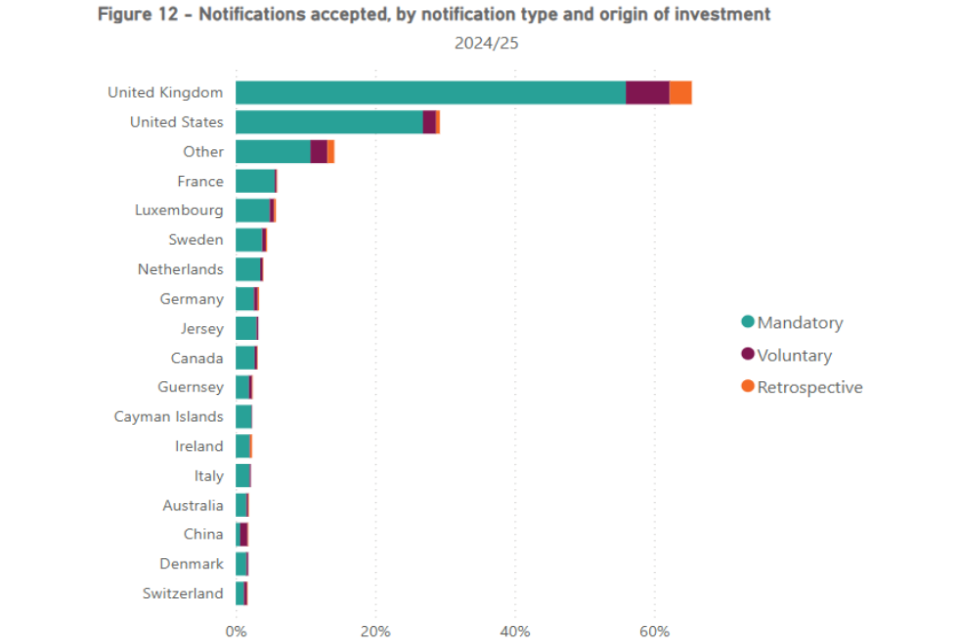
4. Figure 12 presents notifications accepted during the reporting period, broken down by origin of investment. The chart shows that the largest proportion involved acquirers associated with the United Kingdom (65%), followed by acquirers associated with the United States of America (29%), acquirers associated with France (6%) and acquirers associated with Luxembourg (6%). 13% of notifications accepted involved acquirers associated with Others. The origins of investment included in the ‘Other’ category are listed in Annex C. Acquirers associated with the United Kingdom were also involved in the largest proportion of accepted notifications in the previous reporting period (61%).
Call-in notices issued, by origin of investment
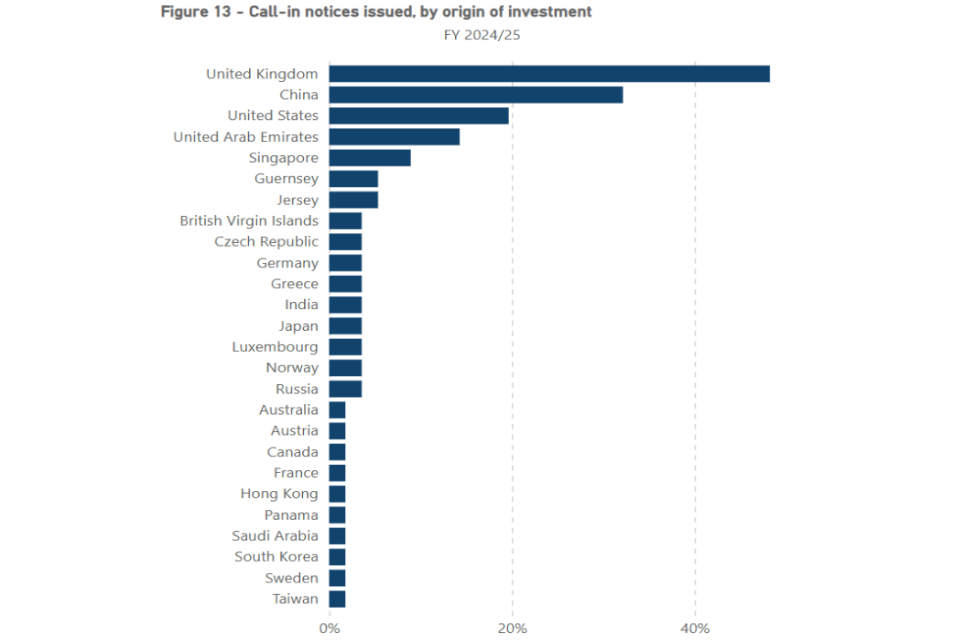
5. Figure 13 presents the 56 call-in notices issued during the reporting period, broken down by origin of investment. The chart shows that the largest proportion involved acquirers associated with the United Kingdom (48%), followed by acquirers associated with China (32%) and acquirers associated with the United States of America (20%). It is important to note that 48% of called-in acquisitions were associated with the United Kingdom, not that 45% of reviewed acquisitions associated with the United Kingdom were called in.
6. For comparison, the largest proportion of called-in acquisitions in the previous reporting period involved acquirers associated with China (41%).
Final notifications issued, by origin of investment
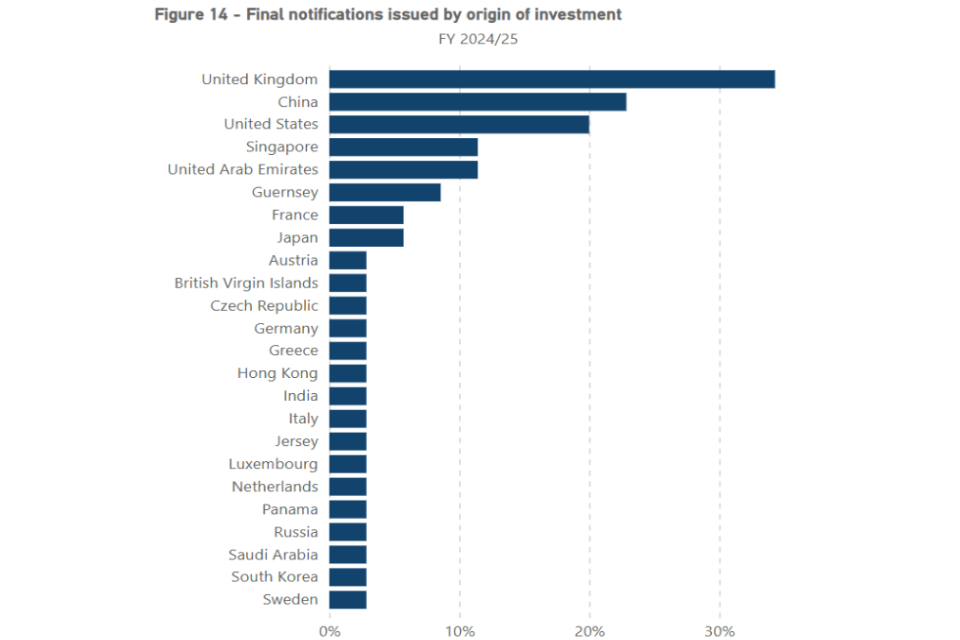
7. Figure 14 presents the 35 final notifications issued during the reporting period, broken down by origin of investment. The chart shows that the largest proportion involved acquirers associated with the United Kingdom (34%), followed by acquirers associated with China (23%) and acquirers associated with the United States of America (20%).
8. For comparison, the largest proportion of final notifications issued in the previous reporting period involved acquirers associated with China (48%).
Withdrawals from a called-in acquisition, by origin of investment
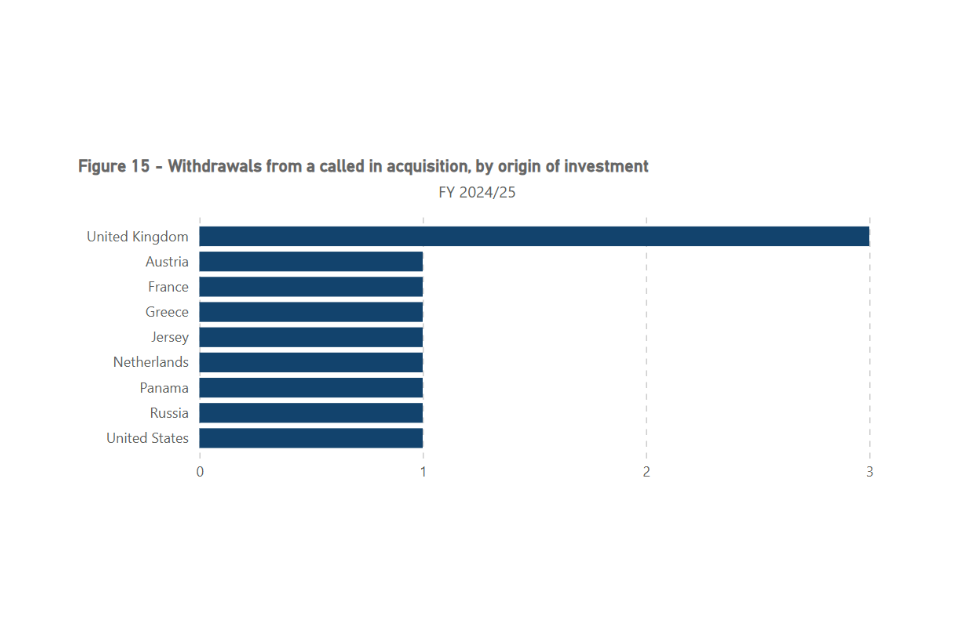
9. Figure 15 presents the five withdrawals from a called-in acquisition during the reporting period, broken down by origin of investment. The chart shows that the largest number involved acquirers associated with the United Kingdom (three withdrawals), followed by Austria, France, Greece, Jersey, Netherlands, Panama, Russia and the United States of America (one withdrawal each).
Final orders issued, by origin of investment
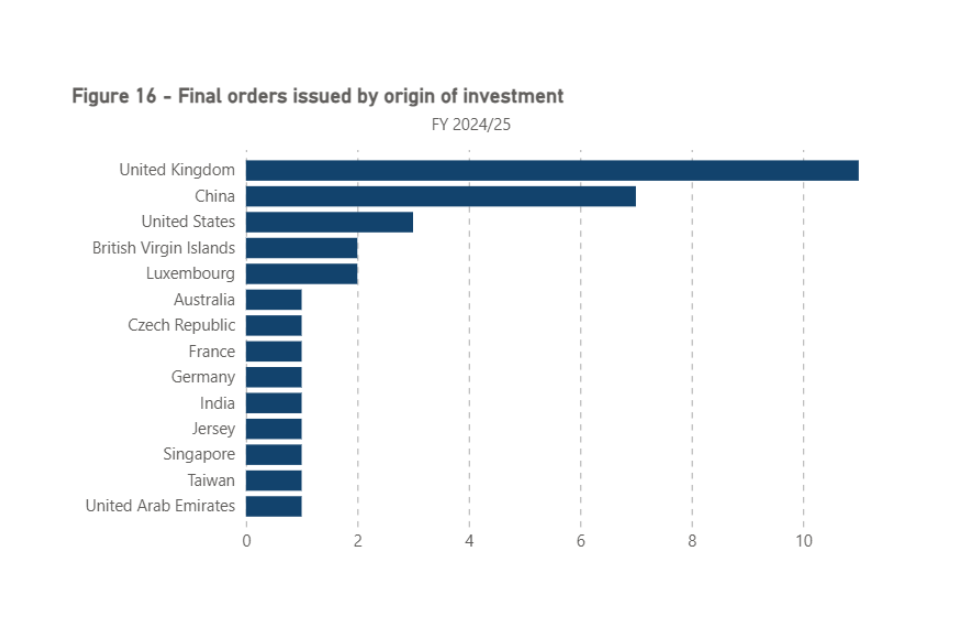
10. Figure 16 presents the 17 final orders issued during the reporting period, broken down by origin of investment. The chart shows that the largest number involved acquirers associated with the United Kingdom (11 final orders), followed by acquirers associated with China (seven final orders) and acquirers associated with the United States of America (three final orders).
11. For comparison, the largest number of final orders in the previous reporting period involved acquirers associated with the United Kingdom (two final orders).
SECTION SEVEN: Time taken to screen acquisitions
1. This section sets out the time taken to accept or reject notifications, call in acquisitions, issue final notifications and final orders, and the number of acquisitions for which the Government used the additional period and voluntary period.
2. When a notification has been submitted, the Government must accept or reject the notification. If the Government decides to accept the notification, it has 30 statutory working days to decide whether to call in the acquisition for a more detailed assessment or to clear it. This is known as the “review period”.
3. If an acquisition is called in, the Government then has 30 statutory working days to undertake a more detailed assessment of national security risk (the “initial period”). If required, it can extend this period by 45 statutory working days (the “additional period”), and the Government and the acquirer can mutually agree to further voluntary extensions (the “voluntary period”).
4. Some of the tables below describe the time taken in “statutory working days” and “calendar working days”. The counting of statutory working days in the assessment period is paused if transaction parties are asked to respond to an information notice or an attendance notice. The use of an information notice does not affect the number of working days during the review period. All counts of case timings exclude days which are bank holidays in any part of the United Kingdom.
Calendar working days to accept or reject a notification
Table 8
| ID | Information | Median working days | Mean working days |
|---|---|---|---|
| The average number of calendar working days from receipt of a… | |||
| A | …mandatory notification to notification of a decision to accept that notification | 7 | 7 |
| B | …mandatory notification to giving written reasons for a decision to reject that notification | 20 | 25 |
| C | …voluntary notification to notification of a decision to accept that notification | 8 | 10 |
| D | …voluntary notification to giving written reasons for a decision to reject that notification | 16 | 32 |
| E | … retrospective validation application to giving reasons for a decision to accept that application | 6 | 8 |
| F | … retrospective validation application to giving reasons for a decision to reject that application | 0 | 0 |
5. Table 8 shows the number of calendar working days it took the Government to accept or reject notifications. The statutory screening period starts from when a notification has been accepted and activates the review period.
6. On average it took seven calendar working days (median) to accept a mandatory notification and eight calendar working days (median) to accept a voluntary notification. For comparison, in the previous reporting period it took on average six calendar working days (median) to accept a mandatory notification and eight calendar working days (median) to accept a voluntary notification.
7. On average it took 20 calendar working days (median) to reject a mandatory notification and 16 calendar working days (median) to reject a voluntary notification. For comparison, in the previous reporting period it took on average 13 calendar working days (median) to reject a mandatory notification and 15 calendar working days (median) to reject a voluntary notification. The increase in time taken is attributed to one mandatory and one voluntary notification that took significantly longer to reject due to circumstances beyond the Government’s control.
Statutory working days to call in notifications
Table 9
| ID | Information | Median working days | Mean working days |
|---|---|---|---|
| The average number of statutory working days to decide to call in… | |||
| G | … a mandatory notification once accepted | 29 | 28 |
| H | … a voluntary notification once accepted | 29 | 28 |
8. On average it took 29 statutory working days (median) to decide to call in a mandatory or a voluntary notification once accepted. Timings are excluded for retrospective validations, due to the small number of acquisitions (1). For comparison, in the previous reporting period, on average it took 29 statutory working days (median) to decide to call in both a mandatory notification and a voluntary notification, once accepted.
Called-in acquisitions that used the additional and voluntary period
9. Tables 10, 11 and 12 show how many additional period notices and voluntary period notices were issued for called-in acquisitions. The full lifecycle of an acquisition may cover more than one reporting period. This means that the use of the additional and voluntary periods may be in a different reporting period to the decision to call in that acquisition, or the decision to issue a final notification or a final order in relation to that acquisition.
Table 10
| ID | Information | Number |
|---|---|---|
| I | The number of times an additional period notice was issued in the reporting period for acquisitions that were called in during this or a previous reporting period | 21 |
| J | The number of times an additional period notice was issued in the reporting period for acquisitions that were called in during this or a previous reporting period following a mandatory notification | 14 |
| K | The number of times an additional period notice was issued in the reporting period for acquisitions that were called in during this or a previous reporting period following a voluntary notification | 4 |
| L | The number of times an additional period notice was issued in the reporting period for acquisitions that were called in during this or a previous reporting period following a retrospective validation application | 0 |
| M | The number of times an additional period notice was issued in the reporting period for acquisitions that were called in during this or a previous reporting period for non-notified acquisitions | 3 |
10. Table 10 shows that 21 called-in acquisitions went to the additional period during the reporting period, of which 14 originated from mandatory notifications, four from voluntary notifications and three following non-notified acquisitions. None of these acquisitions originated from retrospective validation applications. For comparison, the total number of called-in acquisitions that went to the additional period in the previous reporting period was 12.
Table 11
| ID | Information | Number |
|---|---|---|
| N | The number of times a voluntary period notice was agreed in the reporting period for acquisitions that were called in during this or a previous reporting period | 2 |
| O | The number of times a voluntary period notice was agreed in the reporting period for acquisitions that were called in during this or a previous reporting period following a mandatory notification | 1 |
| P | The number of times a voluntary period notice was agreed in the reporting period for acquisitions that were called in during this or a previous reporting period following a voluntary notification | 0 |
| Q | The number of times a voluntary period notice was agreed in the reporting period for acquisitions that were called in during this or a previous reporting period following a retrospective validation application | 0 |
| R | The number of times a voluntary period notice was agreed that were called in during this or a previous reporting period for non-notified acquisitions | 1 |
11. Table 11 shows that the voluntary period was agreed for two called-in acquisitions, of which one originated from a mandatory notification and one originated from a non-notified acquisition. None of these acquisitions originated from a voluntary notification or a retrospective validation application. For comparison, the voluntary period was agreed for three called-in acquisitions in the previous reporting period was three[footnote 18].
Table 12
| ID | Information | Number |
|---|---|---|
| S | The number of times the additional period was used for acquisitions that were called in during this or a previous reporting period and subsequently issued a final notification in the reporting period | 5 |
| T | The number of times the voluntary period was agreed for acquisitions that were called in during this or a previous reporting period and subsequently issued a final notification in the reporting period | 0 |
| U | The number of times the additional period was used for acquisitions that were called in during this or a previous reporting period and subsequently issued a final order in the reporting period | 17 |
| V | The number of times the voluntary period was agreed for acquisitions that were called in during this or a previous reporting period and subsequently issued a final order in the reporting period | 1 |
12. Table 12 shows how many times the additional period had been used and the voluntary period had been agreed for acquisitions that received final orders or final notifications in the reporting period.
13. The additional period was used five times in relation to acquisitions which were subsequently issued a final notification in the reporting period. For comparison, the additional period was used seven times in relation to acquisitions which were subsequently issued a final notification in the previous reporting period. Meanwhile, the voluntary period was not required for any acquisitions that were subsequently issued a final notification, compared to the two times the voluntary period agreed in the previous reporting period.
14. The additional period was used 17 times in relation to acquisitions which were subsequently issued a final order. For comparison, the additional period was used three times in relation to acquisitions which were subsequently issued a final order in the previous reporting period. Meanwhile, the voluntary period was agreed for one acquisition that was subsequently issued a final order[footnote 19], the same as in the previous reporting period.
Calendar and statutory working days to issue a final notification
15. Table 13 provides the average number of calendar and statutory working days taken to issue a final notification for notified acquisitions which were called in during this or a previous reporting period. These statistics cover acquisitions for which the Government received and accepted the notification and called in the acquisition during this or a previous reporting period, then subsequently issued a final notification in the reporting period
Table 13
The average number of days between…
| ID | Information | Statutory working days - Median | Statutory working days - Mean | Calendar working days - Median | Calendar working days - Mean |
|---|---|---|---|---|---|
| W | … receiving a notification and issuing a final notification | 59 | 60 | 74 | 80 |
| X | … accepting a notification and issuing a final notification | 52 | 52 | 66 | 72 |
| Y | … calling in a notified acquisition and issuing a final notification | 24 | 23 | 40 | 44 |
16. In the reporting period, it took on average 59 statutory working days or 74 calendar working days (median) and 60 statutory working days or 80 calendar working days (mean) between receiving a notification and issuing a final notification.
17. Table 14 provides the average number of statutory and calendar working days taken to issue a final notification for all acquisitions (notified and non-notified).
Table 14
| ID | Information | Statutory working days - Median | Statutory working days - Mean | Calendar working days - Median | Calendar working days - Mean |
|---|---|---|---|---|---|
| Z | The average number of days between calling in a notified or a non-notified acquisition and issuing a final notification | 24 | 24 | 40 | 44 |
18. In the reporting period, it took on average 24 statutory working days or 40 calendar working days (median) and 24 statutory working days or 44 calendar working days (mean) between calling in an acquisition (including non-notified acquisitions) and issuing a final notification. In comparison, in the previous reporting period it took on average 26 statutory working days or 48 calendar working days (median) and 31 statutory working days or 61 calendar working days (mean) between calling in an acquisition and issuing a final notification.
Calendar and statutory working days to issue a final order
19. Table 15 provides the average number of statutory and calendar working days taken to issue a final order for notified acquisitions. These statistics cover acquisitions for which the Government received and accepted the notification and called in the acquisition during this or a previous reporting period, then subsequently issued a final order in the reporting period.
Table 15
The average number of days between…
| ID | Information | Statutory working days - Median | Statutory working days - Mean | Calendar working days - Median | Calendar working days - Mean |
|---|---|---|---|---|---|
| AA | … receiving a notification and issuing a final order | 103 | 96 | 136 | 135 |
| AB | … accepting a notification and issuing a final order | 98 | 89 | 125 | 127 |
| AC | … calling in a notified acquisition and issuing a final order | 70 | 63 | 99 | 102 |
20. In the reporting period, it took on average 103 statutory working days or 136 calendar working days (median) and 96 statutory working days or 135 calendar working days (mean) between receiving a notification and issuing a final order.
21. Table 16 provides the average number of statutory working days to issue a final order for all acquisitions (notified and non-notified).
Table 16
| ID | Information | Statutory working days - Median | Statutory working days - Mean | Calendar working - Median | Calendar working - Mean |
|---|---|---|---|---|---|
| AD | The average number of days between calling in a notified or a non-notified acquisition and issuing a final order | 70 | 69 | 100 | 110 |
22. In the reporting period, it took on average 70 statutory working days or 100 calendar working days (median) and 69 statutory working days or 110 calendar working days (mean) between calling in an acquisition (including non-notified acquisitions) and issuing a final order. In comparison, in the previous reporting period it took on average 34 statutory working days or 53 calendar working days (median) and 51 statutory working days or 75 calendar working days (mean) between calling in an acquisition and issuing a final order. Due to the small number of final orders (5) in the previous reporting period, no conclusions should be drawn regarding trends in the time taken between calling in an acquisition and issuing a final order.
SECTION EIGHT: Financial assistance
1. The Government may give financial assistance to or in respect of an entity as a consequence of making a final order. This may be any form of financial assistance (actual or contingent) including loans, guarantees or indemnities. Such assistance must be made with the consent of HM Treasury.
2. No financial assistance has been given during the reporting period. There are therefore no liabilities in respect of financial assistance.
SECTION NINE: Appeals, Compliance, and Enforcement
1. The NSI Act specifies that offences may be committed in respect of:
a. completing a notifiable acquisition without approval;
b. failing to comply with an interim or final order;
c. failing to comply with an information notice or attendance notice, and various associated offences; and,
d. using or disclosing information in contravention of the NSI Act’s provisions regarding the disclosure of information.
2. For the reporting period the Government did not issue any penalties, and consequently, there were no appeals against penalties or costs. There were no criminal prosecutions concluded during this time period.
3. During the reporting period, the Government identified 60 offences of completing a notifiable acquisition without approval. Penalties were not imposed in these cases but parties were required to provide reassurance to the Government that steps had been taken to prevent any future non-compliance.
Contacting the Investment Security Unit
1. You can contact the Investment Security Unit (ISU) through its mailbox at investment.screening@cabinetoffice.gov.uk with any questions regarding the operation of the NSI Act or this publication.
2. Please visit National Security and Investment Act for full details of the operation of the NSI Act, including comprehensive guidance.
Annex A: Summary of statistics and figures in this report
1. The following tables summarise the statistics and figures contained in this report. The accompanying spreadsheet containing all the data published since commencement of the NSI Act can be found on gov.uk.
2. The table below summarises the statistics in the reporting period (1 April 2024 - 31 March 2025).
STATISTICS INCLUDED IN THIS REPORT
SECTION ONE: Notifications
| ID | Information | Number |
|---|---|---|
| A | The total number of notifications received | 1,143 |
| B | The number of mandatory notifications received | 954 |
| C | The number of voluntary notifications received | 134 |
| D | The number of retrospective validation applications received | 55 |
| E | The total number of notifications accepted or rejected | 1,147 |
| F | The total number of notifications accepted | 1,110 |
| G | The total number of notifications rejected | 37 |
| H | The number of mandatory notifications accepted | 942 |
| I | The number of mandatory notifications rejected | 18 |
| J | The number of voluntary notifications accepted | 116 |
| K | The number of voluntary notifications rejected | 19 |
| L | The number of retrospective validation applications accepted | 52 |
| M | The number of retrospective validation applications rejected | 0 |
| N | The number of notifications pending acceptance and rejection at the end of the reporting period | 33 |
SECTION TWO: Call-in notices
| ID | Information | Number |
|---|---|---|
| A | The total number of notified acquisitions reviewed | 1,079 |
| B | The number of acquisitions reviewed following a mandatory notification | 912 |
| C | The number of acquisitions reviewed following a voluntary notification | 120 |
| D | The number of acquisitions reviewed following a retrospective validation application | 47 |
| E | The total number of call-in notices issued | 56 |
| F | The number of call-in notices issued following a mandatory notification | 28 |
| G | The number of call-in notices issued following a voluntary notification | 20 |
| H | The number of call-in notices issued following a retrospective validation application | 1 |
| I | The number of call-in notices issued for non-notified acquisitions | 7 |
SECTION THREE: Final notifications
| ID | Information | Number |
|---|---|---|
| A | The total number of final notifications issued | 35 |
| B | The number of final notifications issued following a mandatory notification | 20 |
| C | The number of final notifications issued following a voluntary notification | 11 |
| D | The number of final notifications issued following a retrospective validation application | 0 |
| E | The number of final notifications issued for non-notified acquisition | 4 |
| F | The total number of withdrawals from a called-in acquisition | 5 |
| G | The number of withdrawals from a called-in acquisition following a mandatory notification | 4 |
| H | The number of withdrawals from a called-in acquisition following a voluntary notification | 0 |
| I | The number of withdrawals from a called-in acquisition following a retrospective validation application | 0 |
| J | The number of withdrawals from a called-in acquisition for non-notified acquisitions | 1 |
SECTION FOUR: Final orders
| ID | Information | Number |
|---|---|---|
| A | The number of final orders issued | 17 |
| B | The number of final orders issued following a mandatory notification | 11 |
| C | The number of final orders issued following a voluntary notification | 5 |
| D | The number of final orders issued following a retrospective validation application | 0 |
| E | The number of final orders issued for non-notified acquisitions | 1 |
| F | The number of acquisitions blocked or subject to an order to unwind the acquisition | 1 |
| G | The number of final orders varied | 3 |
| H | The number of final orders revoked | 3 |
SECTION SEVEN: Time taken
| ID | Information | Median | Mean |
|---|---|---|---|
| A | The average number of calendar working days from receipt of a mandatory notification to notification of a decision to accept that notification | 7 | 7 |
| B | The average number of calendar working days from receipt of a mandatory notification to giving written reasons for a decision to reject that notification | 20 | 25 |
| C | The average number of calendar working days from receipt of a voluntary notification to notification of a decision to accept that notification | 8 | 10 |
| D | The average number of calendar working days from receipt of a voluntary notification to giving written reasons for a decision to reject that notification | 16 | 32 |
| E | The average number of calendar working days from receipt of a retrospective validation application to notification of a decision to accept that application | 6 | 8 |
| F | The average number of calendar working days from receipt of a retrospective validation application to giving written reasons for a decision to reject that application | 0 | 0 |
| G | The average number of statutory working days to decide to call in a mandatory notification once accepted | 29 | 28 |
| H | The average number of statutory working days to decide to call in a voluntary notification once accepted | 29 | 28 |
| ID | Information | Number |
|---|---|---|
| I | The total number of times an additional period notice was issued in the reporting period for acquisitions that were called in during this or a previous reporting period | 21 |
| J | The number of times an additional period notice was issued in the reporting period for acquisitions that were called in during this or a previous reporting period following a mandatory notification | 14 |
| K | The number of times an additional period notice was issued in the reporting period for acquisitions that were called in during this or a previous reporting period following a voluntary notification | 4 |
| L | The number of times an additional period notice was issued in the reporting period for acquisitions that were called in during this or a previous reporting period following a retrospective validation application | 0 |
| M | The number of times an additional period notice was issued in the reporting period for acquisitions that were called in during this or a previous reporting period for non-notified acquisitions | 3 |
| N | The total number of times a voluntary period notice was agreed in the reporting period for acquisitions that were called in during this or a previous reporting period | 2 |
| O | The number of times a voluntary period notice was agreed in the reporting period for acquisitions that were called in during this or a previous reporting period following a mandatory notification | 1 |
| P | The number of times a voluntary period notice was agreed in the reporting period for acquisitions that were called in during this or a previous reporting period following a voluntary notification | 0 |
| Q | The number of times a voluntary period notice was agreed in the reporting period for acquisitions that were called in during this or a previous reporting period following a retrospective validation application | 0 |
| R | The number of times a voluntary period notice was agreed in the reporting period for acquisitions that were called in during this or a previous reporting period for non-notified acquisitions | 1 |
| S | The number of times the additional period was issued for acquisitions that were called in during this or a previous reporting period and subsequently issued a final notification in the reporting period | 5 |
| T | The number of times the voluntary period was agreed for acquisitions that were called in during this or a previous reporting period and subsequently issued a final notification in the reporting period | 0 |
| U | The number of times the additional period was issued for acquisitions that were called in during this or a previous reporting period and subsequently issued a final order in the reporting period | 17 |
| V | The number of times the voluntary period was agreed for acquisitions that were called in during this or a previous reporting period and subsequently issued a final order in the reporting period | 1 |
| ID | Information | Median | Mean |
|---|---|---|---|
| W | The average number of statutory working days between receiving a notification and issuing a final notification | 59 | 60 |
| W | The average number of calendar working days between receiving a notification and issuing a final notification | 74 | 80 |
| X | The average number of statutory working days between accepting a notification and issuing a final notification | 52 | 52 |
| X | The average number of calendar working days between accepting a notification and issuing a final notification | 66 | 72 |
| Y | The average number of statutory working days between calling in a notified acquisition and issuing a final notification | 24 | 23 |
| Y | The average number of calendar working days between calling in a notified acquisition and issuing a final notification | 40 | 44 |
| Z | The average number of statutory working days between calling in a notified or non-notified acquisition and issuing a final notification | 24 | 24 |
| Z | The average number of calendar working days between calling in a notified or non-notified acquisition and issuing a final notification | 40 | 44 |
| AA | The average number of statutory working days between receiving a notification and issuing a final order | 103 | 96 |
| AA | The average number of calendar working days between receiving a notification and issuing a final order | 136 | 135 |
| AB | The average number of statutory working days between accepting a notification and issuing a final order | 98 | 89 |
| AB | The average number of calendar working days between accepting a notification and issuing a final order | 125 | 127 |
| AC | The average number of statutory working days between calling in a notified acquisition and issuing a final order | 70 | 63 |
| AC | The average number of calendar working days between calling in a notified acquisition and issuing a final order | 99 | 102 |
| AD | The average number of statutory working days between calling in a notified or non-notified acquisition and issuing a final order | 70 | 69 |
| AD | The average number of calendar working days between calling in a notified or non-notified acquisition and issuing a final order | 100 | 110 |
Section One: Notifications
| Information | Figure |
|---|---|
| The number of notifications received, by notification type and month | Fig 1 |
| The number of notifications accepted or rejected, by month | Fig 2 |
| The number of notifications accepted, by notification type and month | Fig 3 |
| The number of notifications rejected, by notification type and month | Fig 4 |
| The number of notifications rejected, by the reason why they were rejected | Fig 5 |
Section Two: Call-in notices
| Information | Figure |
|---|---|
| The number of call-in notices issued, by notification type and month | Fig 6 |
Section Five: Areas of the economy
| Information | Figure |
|---|---|
| The breakdown of notifications accepted or rejected, by notification type and area of the economy | Fig 7 |
| The breakdown of call-in notices issued, by area of the economy | Fig 8 |
| The breakdown of final notifications issued, by area of the economy | Fig 9 |
| The number of withdrawals from a called-in acquisition, by area of the economy | Fig 10 |
| The number of final orders issued, by area of the economy | Fig 11 |
Section Six: Origin of Investment
| Information | Figure |
|---|---|
| The breakdown of notifications accepted, by notification type and origin of investment | Fig 12 |
| The breakdown of call-in notices issued, by origin of investment | Fig 13 |
| The breakdown of final notifications issued, by origin of investment | Fig 14 |
| The number of withdrawals from a called-in acquisition, by origin of investment | Fig 15 |
| The number of final orders issued, by origin of investment | Fig 16 |
Annex B: Information contained in this report
1. The NSI Act 2021 specifies information that must be included in each Annual Report. The Government includes additional information to assist stakeholders in their understanding of the operation of the NSI Act and to maintain high standards of transparency.
STATUTORY INFORMATION INCLUDED IN THIS REPORT
| Information | Page number |
|---|---|
| The number of mandatory notifications accepted | 12 |
| The number of mandatory notifications rejected | 12 |
| The number of voluntary notifications accepted | 12 |
| The number of voluntary notifications rejected | 12 |
| The total number of call-in notices issued | 15 |
| The total number of final notifications issued | 17 |
| The number of final orders issued | 19 |
| The number of final orders varied | 19 |
| The number of final orders revoked | 19 |
| The breakdown of notifications accepted or rejected, by notification type and area of the economy | 20 |
| The breakdown of call-in notices issued, by area of the economy | 21 |
| The average number of calendar working days from receipt of a mandatory notification to notification of a decision to accept that notification | 28 |
| The average number of calendar working days from receipt of a mandatory notification to giving written reasons for a decision to reject that notification | 28 |
| The average number of calendar working days from receipt of a voluntary notification to notification of a decision to accept that notification | 28 |
| The average number of calendar working days from receipt of a voluntary notification to giving written reasons for a decision to reject that notification | 28 |
| The expenditure incurred by the Government in giving, or in connection with giving, financial assistance falling within Section 30 | 34 |
| The amount of the actual or contingent liabilities of the Government at the end of the relevant period in respect of such financial assistance | 34 |
ADDITIONAL INFORMATION INCLUDED FROM PREVIOUS REPORTS
| Information | Page number |
|---|---|
| The total number of notifications received | 10 |
| The number of mandatory notifications received | 10 |
| The number of voluntary notifications received | 10 |
| The number of retrospective validation applications received | 10 |
| The number of notifications received, by notification type and month | 11 |
| The total number of notifications accepted and rejected | 12 |
| The total number of notifications accepted | 12 |
| The total number of notifications rejected | 12 |
| The number of retrospective validation applications accepted | 12 |
| The number of retrospective validation applications rejected | 12 |
| The number of notifications pending acceptance or rejection at the end of the reporting period | 12 |
| The number of notifications accepted or rejected, by month | 12 |
| The number of notifications accepted, by notification type and month | 13 |
| The number of notifications rejected, by notification type and month | 13 |
| The number of notifications rejected, by the reason why they were rejected | 14 |
| The total number of notified acquisitions reviewed | 15 |
| The number of acquisitions reviewed following a mandatory notification | 15 |
| The number of acquisitions reviewed following a voluntary notification | 15 |
| The number of acquisitions reviewed following a retrospective validation application | 15 |
| The number of call-in notices issued following a mandatory notification | 15 |
| The number of call-in notices issued following a voluntary notification | 15 |
| The number of call-in notices issued following a retrospective validation application | 15 |
| The number of call-in notices issued for non-notified acquisitions | 15 |
| The number of call-in notices issued, by notification type and month | 16 |
| The number of final notifications issued following a mandatory notification | 17 |
| The number of final notifications issued following a voluntary notification | 17 |
| The number of final notifications issued following a retrospective validation application | 17 |
| The number of final notifications issued for non-notified acquisitions | 17 |
| The total number of withdrawals from a called in acquisition | 18 |
| The number of withdrawals from a called in acquisition following a mandatory notification | 18 |
| The number of withdrawals from a called in acquisition following a voluntary notification | 18 |
| The number of withdrawals from a called in acquisition following a retrospective validation application | 18 |
| The number of withdrawals from a called in acquisition for non-notified acquisitions | 18 |
| The number of final orders issued following a mandatory notification | 19 |
| The number of final orders issued following a voluntary notification | 19 |
| The number of final orders issued following a retrospective validation application | 19 |
| The number of final orders issued for non-notified acquisitions | 19 |
| The number of acquisitions blocked or subject to an order to unwind the acquisition | 19 |
| The breakdown of final notifications issued, by area of the economy | 22 |
| The number of withdrawals from a called in acquisition, by area of the economy | 22 |
| The number of final orders issued, by area of the economy | 23 |
| The breakdown of notifications accepted, by notification type and origin of investment | 24 |
| The breakdown of call-in notices issued, by origin of investment | 25 |
| The breakdown of final notifications issued, by origin of investment | 26 |
| The number of withdrawals from a called in acquisition, by origin of investment | 27 |
| The number of final orders issued, by origin of investment | 27 |
| The average number of calendar working days from receipt of a retrospective validation application to giving reasons for a decision to accept that application | 28 |
| The average number of calendar working days from receipt of a retrospective validation application to giving reasons for a decision to reject that application | 28 |
| The average number of statutory working days to decide to call in a mandatory notification once accepted | 29 |
| The average number of statutory working days to decide to call in a voluntary notification once accepted | 29 |
| The total number of times an additional period notice was issued in this reporting period for acquisitions that were called in during this or a previous reporting period | 29 |
| The number of times an additional period notice was issued in this reporting period for acquisitions that were called in during this or a previous reporting period following a mandatory notification | 29 |
| The number of times an additional period notice was issued in this reporting period for acquisitions that were called in during this or a previous reporting period following a voluntary notification | 29 |
| The number of times an additional period notice was issued in this reporting period for acquisitions that were called in during this or a previous reporting period following a retrospective validation application | 30 |
| The number of times an additional period notice was issued in this reporting period for acquisitions that were called in during this or a previous reporting period for non-notified acquisitions | 30 |
| The total number of times a voluntary period notice was agreed in this reporting period for acquisitions that were called in during this or a previous reporting period | 30 |
| The number of times a voluntary period notice was agreed in this reporting period for acquisitions that were called in during this or a previous reporting period following a mandatory notification | 30 |
| The number of times a voluntary period notice was agreed in this reporting period for acquisitions that were called in during this or a previous reporting period following a voluntary notification | 30 |
| The number of times a voluntary period notice was agreed in this reporting period for acquisitions that were called in during this or a previous reporting period following a retrospective validation application | 30 |
| The number of times a voluntary period notice was agreed in this reporting period for acquisitions that were called in during this or a previous reporting period for non-notified acquisitions | 30 |
| The number of times the additional period was issued for acquisitions that were called in during this or a previous reporting period and subsequently issued a final notification in this reporting period | 31 |
| The number of times the voluntary period was agreed for acquisitions that were called in during this or a previous reporting period and subsequently issued a final notification in this reporting period | 31 |
| The number of times the additional period was issued for acquisitions that were called in during this or a previous reporting period and subsequently issued a final order in this reporting period | 31 |
| The number of times the voluntary period was agreed for acquisitions that were called in during this or a previous reporting period and subsequently issued a final order in this reporting period | 31 |
| The average number of statutory working days between receiving a notification and issuing a final notification | 32 |
| The average number of calendar working days between receiving a notification and issuing a final notification | 32 |
| The average number of statutory working days between accepting a notification and issuing a final notification | 32 |
| The average number of calendar working days between accepting a notification and issuing a final notification | 32 |
| The average number of statutory working days between calling in a notified acquisition and issuing a final notification | 32 |
| The average number of calendar working days between calling in a notified acquisition and issuing a final notification | 32 |
| The average number of statutory working days between calling in a notified or non-notified acquisition and issuing a final notification | 32 |
| The average number of calendar working days between calling in a notified or non-notified acquisition and issuing a final notification | 32 |
| The average number of statutory working days between receiving a notification and issuing a final order | 32 |
| The average number of calendar working days between receiving a notification and issuing a final order | 32 |
| The average number of statutory working days between accepting a notification and issuing a final order | 33 |
| The average number of calendar working days between accepting a notification and issuing a final order | 33 |
| The average number of statutory working days between calling in a notified acquisition and issuing a final order | 33 |
| The average number of calendar working days between calling in a notified acquisition and issuing a final order | 33 |
| The average number of statutory working days between calling in a notified or non-notified acquisition and issuing a final order | 33 |
| The average number of calendar working days between calling in a notified or non-notified acquisition and issuing a final order | 33 |
| The number of offences of completing a notifiable acquisition without approval | 35 |
Annex C: Origins of investment within ‘Other’ in charts
Several origins of investment featured in fewer than ten notifications. In the charts in this Annual Report, these are combined into the ‘Other’ category. The origins of investment included in this category are:
- Austria
- Belgium
- Bermuda
- British Virgin Islands
- Bulgaria
- Cyprus
- Czech Republic
- Estonia
- Finland
- Greece
- Hong Kong
- Hungary
- India
- Isle of Man
- Israel
- Jordan
- South Korea
- Liechtenstein
- Malaysia
- Malta
- Mauritius
- Norway
- Oman
- Panama
- Poland
- Portugal
- Qatar
- Russia
- Saudi Arabia
- Singapore
- South Africa
- Spain
- Taiwan
- Turkey
- Ukraine
- United Arab Emirates
- Vietnam
Annex D: Sankey diagram
The Sankey diagram shows the progress of acquisitions through the different stages, from submitting a notification to communicating a final decision, under the NSI Act during the reporting period.[footnote 20]
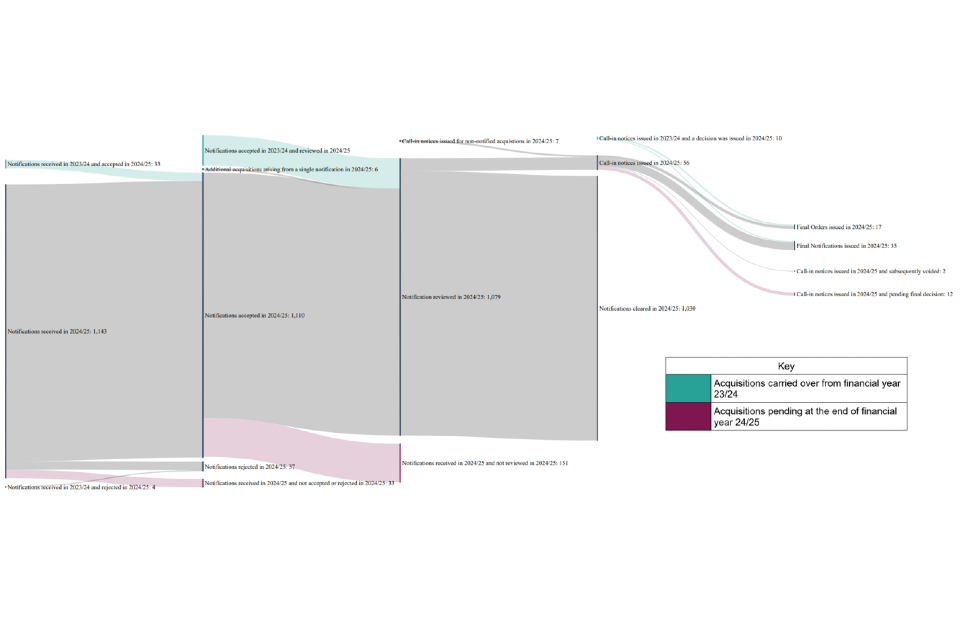
-
Notifications are when parties give notice to the Government about certain acquisitions that meet the legal tests set out in the NSI Act. ↩
-
Retrospective validation application is a form of notifiable acquisition to be recognised retrospectively as being valid in law after having been completed without approval. ↩
-
A call-in notice is issued when the Government calls in an acquisition for further scrutiny if it reasonably suspects that a qualifying acquisition may give rise to a risk to national security. ↩
-
A non-notified acquisition is when the Investment Security Unit identifies qualifying acquisitions through market monitoring which haven’t been notified to the Government and which it believes meets the legal tests set out in the Act. ↩
-
A final notification is issued in relation to a call-in notice before the end of the assessment period when no further action is to be taken. ↩
-
A final order is a legal binding document imposing conditions on an acquisition to mitigate national security risks. ↩
-
In one instance, final orders associated with two related call-in notices were contained within the same document and presented in a single public notice. ↩
-
A varied final order is a modification of a final order that changes the terms or conditions imposed on an acquisition. ↩
-
A revoked final order is the cancellation of a final order imposed on an acquisition. ↩
-
The assessment period begins on the day on which the acquirer is notified that the acquisition has been called in. It ends on the day that the decision to issue a final notification or a final order is communicated to the acquirer. ↩
-
If the government requires further information it may issue an information notice, which requires parties to provide information to support the Secretary of State’s consideration. ↩
-
The government may need to hear from people involved in the acquisition to inform its decision making. This will be required through an attendance notice, setting out the time and place of the meeting, and the purpose of the meeting. ↩
-
The review period begins on the day that a notification is accepted and can last up to 30 working days. ↩
-
The total number of times a voluntary period was agreed in 2023-24 has been revised down from four to three. ↩
-
Two notified acquisitions were reviewed and called in, but the call-in notices were subsequently voided. These notifications are included in the total number of reviewed and called-in notifications and the related statistics. ↩
-
In one instance, final orders associated with two related call-in notices were contained within the same document and presented in a single public notice. ↩
-
Areas of the economy representing less than 1% are excluded from the chart. Data on all areas of the economy is available in the accompanying spreadsheet to the report. ↩
-
The number of times a voluntary period was agreed in 2023-24 has been revised down from four to three. ↩
-
The number of times the voluntary period was agreed for acquisitions that were called in and subsequently issued a final order in 2023-24 has been revised from two to one. ↩
-
The sankey diagram includes the following additional statistics: Notifications received in AR23/24 and rejected in AR24/25: 4, notifications received in AR23/24 and accepted in AR24/25: 33, notifications pending review in AR24/25: 151, additional acquisitions reviewed arising from single notifications in AR24/25: 6. ↩
